
Exploring Cosmos Staking: A Guide to Staking ATOM
With hundreds of networks floating around the crypto scene, finding the right network to invest in can be challenging.
With its growing and vibrant ecosystem of decentralized applications (DApps), Cosmos Blockchain presents a promising network where investors can place their resources. Unlike solo staking with Ethereum, which requires a minimum of 32ETH in staked amounts, Cosmos staking is accessible to most investors.
Cosmos, a Delegated-Proof-of-Stake blockchain, allows anyone holding ATOM (the native token) to stake on the network.
In this article, we discuss how to stake Cosmos:
 The Cosmos ecosystem contains chains focused on specific use cases, such as wallets, storage, and non-fungible tokens (NFTs).
The Cosmos ecosystem contains chains focused on specific use cases, such as wallets, storage, and non-fungible tokens (NFTs).
 The popular self-custodial wallet supports multiple Cosmos-based assets and allows you to stake ATOM directly from the wallet interface. Users may access Keplr either through an Android/iOS mobile app or through a browser application.
Aside from ATOM staking, Keplr supports a host of functions, from NFTs, governance proposals, and crypto purchases. One may also explore the various decentralized apps (DApps) within the Cosmos ecosystem.
The popular self-custodial wallet supports multiple Cosmos-based assets and allows you to stake ATOM directly from the wallet interface. Users may access Keplr either through an Android/iOS mobile app or through a browser application.
Aside from ATOM staking, Keplr supports a host of functions, from NFTs, governance proposals, and crypto purchases. One may also explore the various decentralized apps (DApps) within the Cosmos ecosystem.
 Coinbase is a centralized cryptocurrency exchange known for its simplicity. The leading American-based exchange incentivizes users to stake ATOM directly from their accounts. The staking dashboard also enables investors to monitor ATOM staking rewards easily.
Coinbase excels as an all-in-one platform for trading crypto and crypto passive income opportunities.
Coinbase is a centralized cryptocurrency exchange known for its simplicity. The leading American-based exchange incentivizes users to stake ATOM directly from their accounts. The staking dashboard also enables investors to monitor ATOM staking rewards easily.
Coinbase excels as an all-in-one platform for trading crypto and crypto passive income opportunities.
 If you’re staking via a centralized exchange, you have no choice but to use the exchange’s validator. On the other hand, if you’re using a wallet like Keplr, you have the opportunity to choose from dozens of validators.
If you’re staking via a centralized exchange, you have no choice but to use the exchange’s validator. On the other hand, if you’re using a wallet like Keplr, you have the opportunity to choose from dozens of validators.
 With free websites such as Mint Scan you can view the top validators within Cosmos and their corresponding commission rates and uptime.
Coinbase stands as the largest validator, taking 10.33% of all staked Cosmos. However, it also cuts 20% from your staking rewards. These could be because Coinbase has many users who trust them. These customers would rather stake with the Centralized Exchange rather than create their own self-custody wallet and stake natively.
With free websites such as Mint Scan you can view the top validators within Cosmos and their corresponding commission rates and uptime.
Coinbase stands as the largest validator, taking 10.33% of all staked Cosmos. However, it also cuts 20% from your staking rewards. These could be because Coinbase has many users who trust them. These customers would rather stake with the Centralized Exchange rather than create their own self-custody wallet and stake natively.

- Introduction to Cosmos
- Basic ATOM staking guide
- ATOM staking optimization
- Pros and cons of ATOM staking
What is the Cosmos Network?
The Cosmos Network brands itself as the Internet of Blockchains. It is a decentralized ecosystem of independent blockchains that can interact with each other. It was designed to overcome the limitations of traditional blockchains, such as scalability, usability, and interoperability. Think of the dozens of email systems. Your Gmail is programmed with a different set of code than your Microsoft Outlook. However, they have been made interoperable so that users of both email platforms can send and receive emails.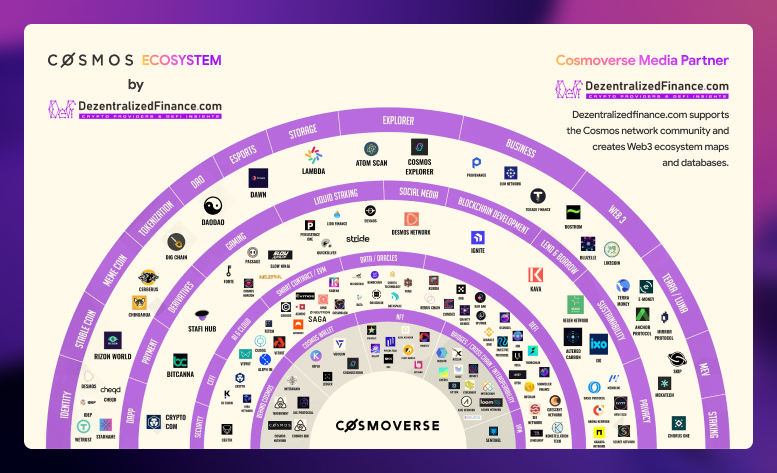 The Cosmos ecosystem contains chains focused on specific use cases, such as wallets, storage, and non-fungible tokens (NFTs).
The Cosmos ecosystem contains chains focused on specific use cases, such as wallets, storage, and non-fungible tokens (NFTs).
How Does Staking Work on the Cosmos Network?
The Cosmos Hub is the first blockchain in the Cosmos Network, designed to connect with other blockchains (zones) using the Inter-Blockchain Communication (IBC) protocol. IBC facilitates the transfer of data and tokens between independent blockchains. The Cosmos Hub relies on a Delegated-Proof-of-Stake consensus mechanism to secure the blockchain. Stakers must obtain ATOM, the native token, and delegate it to a validator. These validators confirm transactions and add new blocks. 180 validators secure the network. By delegating your ATOM to a validator, you help maintain the network's security and earn a share of the rewards distributed by the network. In terms of staking market capitalization, ATOM is the 16th largest network, with $2.18 billion locked onto it.Where Stake Cosmos
There are several platforms where you can stake your ATOM. You can do this through self-custody or a custodial method. A self-custody method allows you to hold your keys and, ultimately, your crypto. Meanwhile, the custodial method involves depositing your crypto into a platform.Keplr
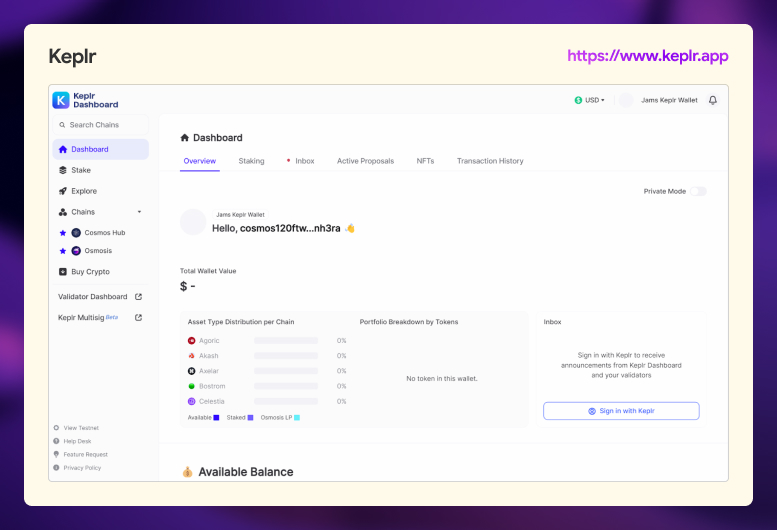 The popular self-custodial wallet supports multiple Cosmos-based assets and allows you to stake ATOM directly from the wallet interface. Users may access Keplr either through an Android/iOS mobile app or through a browser application.
Aside from ATOM staking, Keplr supports a host of functions, from NFTs, governance proposals, and crypto purchases. One may also explore the various decentralized apps (DApps) within the Cosmos ecosystem.
The popular self-custodial wallet supports multiple Cosmos-based assets and allows you to stake ATOM directly from the wallet interface. Users may access Keplr either through an Android/iOS mobile app or through a browser application.
Aside from ATOM staking, Keplr supports a host of functions, from NFTs, governance proposals, and crypto purchases. One may also explore the various decentralized apps (DApps) within the Cosmos ecosystem.
Coinbase
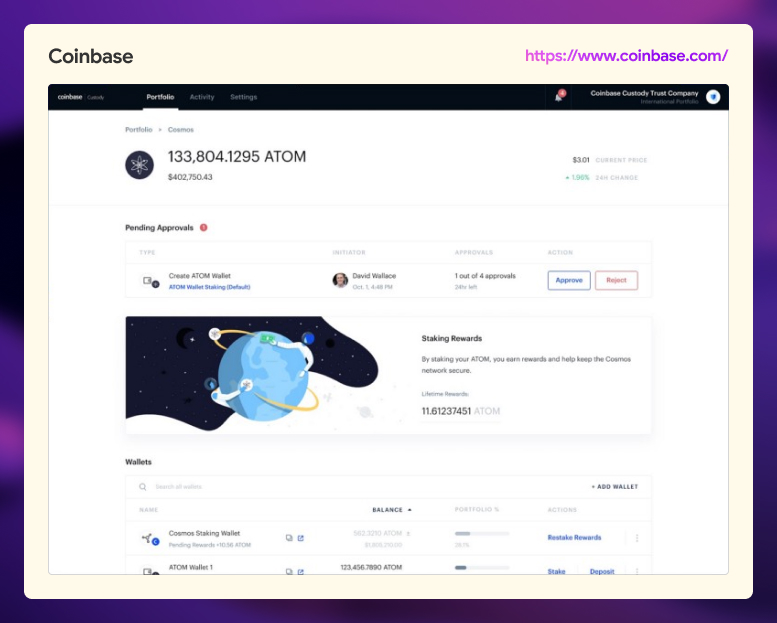 Coinbase is a centralized cryptocurrency exchange known for its simplicity. The leading American-based exchange incentivizes users to stake ATOM directly from their accounts. The staking dashboard also enables investors to monitor ATOM staking rewards easily.
Coinbase excels as an all-in-one platform for trading crypto and crypto passive income opportunities.
Coinbase is a centralized cryptocurrency exchange known for its simplicity. The leading American-based exchange incentivizes users to stake ATOM directly from their accounts. The staking dashboard also enables investors to monitor ATOM staking rewards easily.
Coinbase excels as an all-in-one platform for trading crypto and crypto passive income opportunities.
How to Stake ATOM
Fortunately, staking ATOM is a fairly simple process.. Unlike solo staking Ethereum, which requires a person to set up a computer and learn technical code, users can perform Cosmos staking directly from their smartphones. Here’s a step-by-step process:Choose a Staking Platform
Decide whether to use a self-custodial wallet like Keplr or a centralized exchange like Coinbase or Kraken. Many die-hard crypto participants will tell you, “Not your keys, not your crypto.” However, some people choose to keep their investments on trusted platforms. Access to things such as 24/7 customer support can be non-negotiable for some.Acquire ATOM
Once you’ve set up your exchange account or wallet, you can purchase ATOM on the spot market. You can do this via the exchange. A fiat on-ramp such as MoonPay can execute the same for wallet users.Delegate Your ATOM
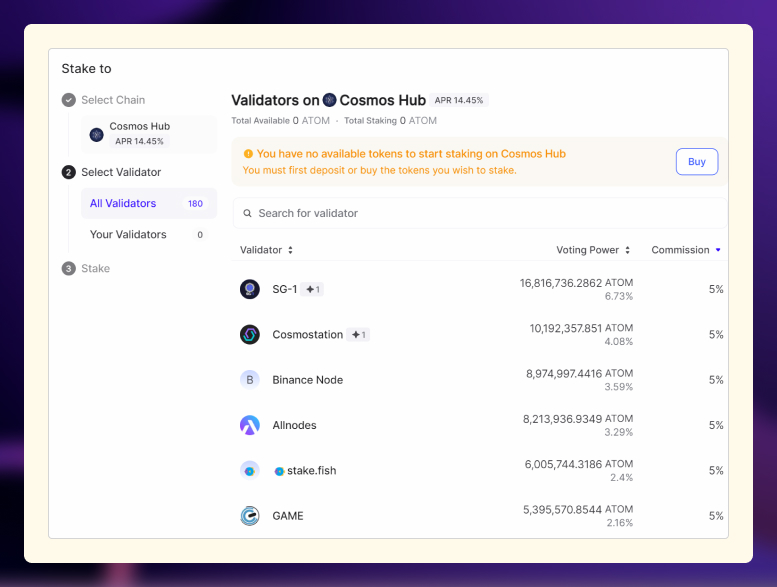 If you’re staking via a centralized exchange, you have no choice but to use the exchange’s validator. On the other hand, if you’re using a wallet like Keplr, you have the opportunity to choose from dozens of validators.
If you’re staking via a centralized exchange, you have no choice but to use the exchange’s validator. On the other hand, if you’re using a wallet like Keplr, you have the opportunity to choose from dozens of validators.
Monitor Your Staked ATOM
Using the respective platform dashboards, you can easily check your ATOM staking rewards and the performance of your chosen validator.Staking Optimization With Cosmos
Maximizing earnings from Cosmos staking involves selecting the proper validator, understanding the staking mechanics, and actively managing your staked tokens. Here are several strategies to help you achieve the best returns:Commission-less Staking
Cosmos Validators take a percentage fee to help maintain their individual operations. Unlike other blockchains’ staking, Cosmos does not have commission-free validators. You’ll have to choose between validators that take less commission but also maintain high reputation.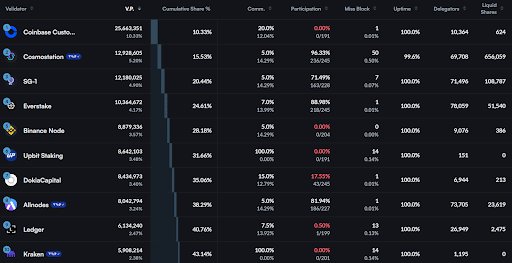 With free websites such as Mint Scan you can view the top validators within Cosmos and their corresponding commission rates and uptime.
Coinbase stands as the largest validator, taking 10.33% of all staked Cosmos. However, it also cuts 20% from your staking rewards. These could be because Coinbase has many users who trust them. These customers would rather stake with the Centralized Exchange rather than create their own self-custody wallet and stake natively.
With free websites such as Mint Scan you can view the top validators within Cosmos and their corresponding commission rates and uptime.
Coinbase stands as the largest validator, taking 10.33% of all staked Cosmos. However, it also cuts 20% from your staking rewards. These could be because Coinbase has many users who trust them. These customers would rather stake with the Centralized Exchange rather than create their own self-custody wallet and stake natively.
Compound Staking Rewards
Reinvesting your rewards leads to compounding staking returns. This can increase your earnings over time. By compounding your rewards, you can take advantage of exponential growth. As Cosmos staking does not have a cap on staked ATOM, you can choose to leave your rewards, and they will automatically compound. You can compound your staking rewards by staking through wallets such as Keplr or centralized exchanges like Coinbse.Diversify Validators
Consider delegating your ATOM to multiple validators to mitigate the slashing risk and maximize your staking rewards. This diversification can help spread the risk and improve overall returns. The minimum required tokens for ATOM staking is small, at less than 0.1 ATOM, so you should be able to choose multiple validators. This is fairly easy to do when you’re staking with a self-custody wallet. Keplr provides staking under a three-step process and flags which validators have relatively high commission.
Stay Informed
Stay updated with the latest developments in Cosmos and the performance of your chosen validators. Being informed allows you to make timely decisions, such as switching validators or taking advantage of special economic opportunities such as airdrops. New blockchains may award their initial tokens to early users and stakers across the Cosmos ecosystem.Pros and Cons of Staking Cosmos Tokens
Like any other blockchain network, Cosmos staking comes with its rewards and risks. Make sure to take note of the following pros and cons before deploying capital into Cosmos staking:Passive Income
Staking ATOM tokens is a potential avenue for passive income. Stakers can earn annual yields, which can be more attractive than traditional financial instruments. As of writing, stakers can earn over 16.0% per annum.Network Security
By staking your ATOM, you contribute to the overall operations of the Cosmos network. This decentralized approach helps prevent attacks and ensures the integrity of the blockchain.Market Volatility
The value of ATOM can fluctuate significantly, impacting the overall returns from staking. Therefore, it's important to consider the potential for market volatility when staking your tokens.Lock-Up Periods
Some staking platforms may require a lock-up period during which your staked ATOM cannot be withdrawn. This can limit your liquidity and flexibility.Time to Start Staking Cosmos
Stake your ATOM to earn passive income and contribute to the network's security. Cosmos also has a growing ecosystem of apps that you can explore. By understanding which platforms provide ATOM staking, you’ll be able to maximize the opportunities that Cosmos has to offer. Before deploying any resources, however, make sure to study all the risks and benefits of doing so. To discover more about the overall process of staking, visit solostakers.comEditor’s Note: This article was originally published in June 2024 but has been updated with new information.
The content of solostakers.com is for informational purposes only and should not be considered financial advice. It represents the personal views and opinions of the author(s) and is not endorsed by any financial institution or regulatory body. Cryptocurrency and staking investments carry inherent risks and readers should conduct their own research and consult with a financial professional before making any investment decisions. The owner and author(s) of solostakers.com will not be liable for any losses, damages, or consequences arising from the use of the information on this site. By accessing solostakers.com, you agree to bear full responsibility for your investment decisions.

Sign Up To Our Newsletter
Curious about deepening your staking knowledge? Explore related content on Solostakers.com and join our community of enthusiasts. Together, we can shape the future of PoS staking.
